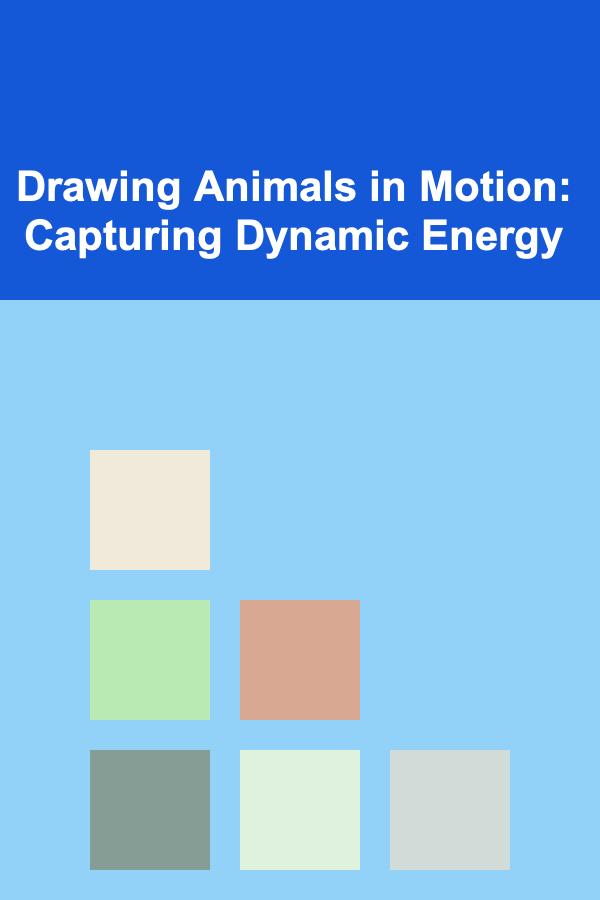
Drawing Animals in Motion: Capturing Dynamic Energy
ebook include PDF & Audio bundle (Micro Guide)
$12.99$6.99
Limited Time Offer! Order within the next:

Drawing animals is a rewarding pursuit, but capturing their movement adds another layer of complexity and artistic expression. Understanding animal anatomy and how it interacts with their environment is crucial to creating believable and dynamic depictions. This article will explore the essential techniques and concepts needed to draw animals in motion effectively, from gesture drawing to conveying speed and weight.
Understanding Animal Anatomy as a Foundation
Before attempting to capture motion, a solid understanding of animal anatomy is paramount. While you don't need to memorize every muscle and bone, knowing the underlying structure allows you to depict movement accurately. Key areas to focus on include:
- Skeletal Structure: The skeleton provides the framework for movement. Knowing the basic bone structure of the animal (spine, limbs, skull, ribcage, pelvis) will help you understand joint articulation and range of motion. Consider how the spine bends and flexes during different gaits.
- Musculature: Muscles power movement. Understanding the primary muscle groups (e.g., leg muscles in a horse, shoulder muscles in a dog) will help you illustrate how they contract and relax during motion. Think about which muscles are stretched and which are contracted based on the animal's pose.
- Proportions: Accurate proportions are essential for believability. Study the proportions specific to the animal you're drawing. For example, a cheetah has significantly different proportions than a bulldog.
Resources for studying animal anatomy include:
- Anatomy Books: Search for books specifically designed for artists. These books often simplify complex anatomical structures and focus on the information most relevant for drawing.
- Online Resources: Websites and online courses offer detailed anatomical diagrams and tutorials.
- Observational Studies: The best way to learn is by observation. Visit zoos, farms, or even your own pets, and carefully study their anatomy and movement. Take photos and videos for later reference.
Example of horse anatomy diagram (Source: Wikimedia Commons)
Gesture Drawing: Capturing the Essence of Movement
Gesture drawing is a fundamental technique for capturing the essence of movement quickly and dynamically. It's not about creating a perfect likeness, but rather about capturing the flow of energy and action within a pose. The goal is to understand the overall movement and weight distribution of the animal.
Here's how to approach gesture drawing:
- Focus on the "Line of Action": The line of action is an imaginary line that runs through the animal's body, representing the main direction of its movement. It often follows the spine or a key limb. It is the most important line in gesture drawing. Exaggerate the curve or angle of the line to emphasize the energy of the pose.
- Use Loose and Fluid Lines: Don't be afraid to use quick, gestural strokes. Keep your hand moving and focus on capturing the feeling of movement rather than precise details. Avoid stiff, hesitant lines.
- Work Quickly: Gesture drawings should be done quickly -- typically within 30 seconds to 2 minutes. This forces you to focus on the essential elements of the pose.
- Emphasize Weight and Balance: Consider how the animal's weight is distributed and how it maintains its balance. The line of action can help you visualize this.
- Look Beyond the Outline: Don't just draw the contour of the animal. Try to understand the volumes and forms beneath the surface.
Practice gesture drawing with various animal poses. Use photographs, videos, or even observe animals in real life. The more you practice, the better you'll become at capturing the essence of movement.
Tip: When practicing gesture drawing, try using different types of pencils or charcoal. Softer materials can encourage looser and more expressive lines.
Simplifying Forms: Using Basic Shapes
After capturing the gesture, you can start building up the form of the animal. A useful technique is to break down the complex forms into simpler geometric shapes, such as:
- Spheres: For the head, ribcage, and joints.
- Cylinders: For limbs, neck, and torso.
- Boxes: For the pelvis and other blocky structures.
These shapes provide a basic framework upon which you can build the more detailed anatomy. By simplifying the forms, you can focus on the overall proportions and structure without getting bogged down in details.
Here's how to use basic shapes:
- Start with the Major Forms: Begin by blocking in the main shapes of the body, such as the head, torso, and pelvis.
- Connect the Shapes: Use cylinders to connect the major forms and create the limbs and neck.
- Refine the Shapes: Gradually refine the shapes, adding curves and contours to make them more realistic.
Example of breaking down an animal into basic shapes (Source: Pinterest)
Foreshortening: Creating Depth and Perspective
Foreshortening is a technique used to create the illusion of depth in a drawing. It involves shortening the length of objects that are receding into the distance, making them appear closer to the viewer. This is crucial when depicting animals in dynamic poses, especially when limbs are extended towards the viewer.
Here are some key points about foreshortening:
- Objects Appear Shorter: The closer an object is to the viewer, the shorter it will appear. For example, a leg extended directly towards the viewer will appear much shorter than a leg that is perpendicular to the viewer's line of sight.
- Overlapping Forms: Overlapping forms can also help to create the illusion of depth. The form in front will partially obscure the form behind it.
- Exaggeration: Don't be afraid to exaggerate the foreshortening effect. This can make the pose more dynamic and dramatic.
- Practice: Foreshortening can be challenging, so practice is essential. Study examples of foreshortening in other drawings and paintings.
Conveying Speed and Weight
To truly capture animals in motion, you need to convey not only their position but also their speed and weight. There are several techniques you can use to achieve this:
- Blurring: Blurring can suggest rapid movement. You can blur the edges of limbs or even the entire animal to create a sense of speed. Experiment with different types of blurring techniques, such as motion blur (a linear blur in the direction of movement) or radial blur (a circular blur around a central point).
- Implied Lines of Force: Draw lines that suggest the direction of the animal's momentum and the forces acting upon it. These lines can be subtle or exaggerated, depending on the desired effect. Imagine the force behind a galloping horse's legs pushing against the ground.
- Exaggerated Poses: Push the poses beyond what is strictly anatomically correct to create a more dynamic and energetic feel. Slightly exaggerate the curve of the spine or the angle of the limbs.
- Dust and Debris: Adding dust, debris, or water splashes can enhance the feeling of movement and impact. Consider how the environment interacts with the animal's movement. For example, a running horse might kick up dust and dirt.
- Weight Distribution: Carefully consider how the animal's weight is distributed. A heavy animal will have a different center of gravity and a different way of moving than a light animal. Emphasize the points of contact with the ground and the muscles that are supporting the animal's weight.
- Contrast: Utilize contrast between light and shadow to accentuate the form and movement. Areas that are stretched or compressed due to motion will have different highlights and shadows.
Consider the specific animal you are drawing and how it moves. A cheetah running at full speed will require different techniques than a turtle slowly crawling along the ground. Observe how the animal interacts with its environment and use that information to inform your drawing.
Using References Effectively
References are invaluable tools for drawing animals in motion. Don't be afraid to use photographs, videos, or even live observation to inform your drawings. However, it's important to use references effectively, rather than simply copying them. Here are some tips:
- Understand the Anatomy: Use references to study the animal's anatomy and movement. Pay attention to the underlying structure and how it affects the animal's pose.
- Analyze the Pose: Before you start drawing, take some time to analyze the pose. Identify the line of action, the key shapes, and the points of emphasis.
- Don't Just Copy: Don't simply copy the reference image. Use it as a guide, but add your own artistic interpretation. Experiment with different angles, poses, and lighting.
- Use Multiple References: Using multiple references can help you create a more complete and accurate understanding of the animal's movement.
- Study from Life: If possible, observe animals in real life. This is the best way to understand their movement and behavior.
Developing Your Own Style
As you practice, you'll naturally develop your own style. Don't be afraid to experiment with different techniques and approaches. Find what works best for you and develop your own unique way of capturing animals in motion. Here are some suggestions:
- Experiment with Different Media: Try drawing with different types of pencils, charcoal, pens, or even digital tools. Each medium has its own unique characteristics and can help you achieve different effects.
- Study the Masters: Study the work of artists who are known for their depictions of animals in motion, such as Rosa Bonheur, Charles R. Knight, and Robert Bateman. Pay attention to their techniques and approaches.
- Embrace Imperfection: Don't strive for perfection. Embrace the imperfections and happy accidents that can occur during the drawing process. These can often add character and personality to your work.
- Practice Consistently: The key to improving your skills is to practice consistently. Set aside time each day or week to draw animals in motion.
- Seek Feedback: Share your work with other artists and ask for feedback. Constructive criticism can help you identify areas where you can improve.
Specific Animal Considerations
Different animals move in different ways. Understanding these differences is essential for accurate depiction. Here are a few examples:
- Horses: Pay close attention to the different gaits of horses (walk, trot, canter, gallop). Each gait has its own unique footfall pattern and body mechanics. The position of the legs and the bend of the spine are critical.
- Cats: Cats are incredibly flexible and agile. Their spine can bend in a wide range of motion, and they have a unique way of moving their limbs. Study their anatomy and pay attention to their balance and coordination. Consider the stalking, pouncing, and leaping motions.
- Dogs: Dogs have a more rigid spine than cats, but they are still capable of a wide range of movement. Pay attention to their gait and how they use their tail for balance. Consider the difference between running, playing, and guarding stances.
- Birds: Birds are masters of flight. Understand the mechanics of their wings and how they generate lift. Pay attention to the angle of the wings, the position of the feathers, and the overall shape of the bird. Consider soaring, diving, and hovering movements.
- Fish: Fish move through water by undulating their bodies and fins. Pay attention to the shape of the body and the movement of the fins. Consider the environment - are they swimming against a current?
Research the specific animal you are drawing to understand its unique anatomy and movement patterns. This will help you create a more accurate and believable depiction.
Final Thoughts
Drawing animals in motion is a challenging but rewarding skill. By understanding animal anatomy, practicing gesture drawing, simplifying forms, and conveying speed and weight, you can create dynamic and expressive depictions of animals in action. Remember to use references effectively, develop your own style, and practice consistently. With dedication and perseverance, you'll be able to capture the beauty and energy of the animal kingdom in your art.
Reading More From Our Other Websites
- [Soap Making Tip 101] Indulge Your Senses: Aromatherapy & Skincare Benefits of Cocoa Butter Soap
- [Trail Running Tip 101] Trail Running 101: Essential Gear and How to Choose the Right Shoes
- [Trail Running Tip 101] Top 7 Tips for Organizing Safe and Fun Trail Runs with Friends
- [Home Budget 101] How to Budget for Seasonal Home Maintenance Tasks
- [Home Storage Solution 101] How to Master Cable Management Solutions for a Clutter-Free Entertainment Center
- [Soap Making Tip 101] Eco-Friendly Soap Making: Sustainable Ingredients and Zero-Waste Tips
- [Home Soundproofing 101] How to Prevent Noise Transfer Through Air Vents and Ducts
- [Organization Tip 101] How to Organize Books by Age and Interest
- [Tiny Home Living Tip 101] Best Practices for Off‑Grid Solar Power in Tiny Home Living
- [Weaving Tip 101] From Fiber to Fabric: The Art and Science of Modern Weaving

How to Choose the Right Furniture for Easy Organization
Read More
How to Design a User-Friendly Interface for Your Mobile App
Read More
Finding Adventure in the Volcanoes of Hawaii
Read More
Zumba for Beginners: How to Learn the Basic Steps
Read More
How to Protect Your Retirement Savings During Divorce
Read More
10 Tips for Organizing Financial Documents Before Divorce
Read MoreOther Products

How to Choose the Right Furniture for Easy Organization
Read More
How to Design a User-Friendly Interface for Your Mobile App
Read More
Finding Adventure in the Volcanoes of Hawaii
Read More
Zumba for Beginners: How to Learn the Basic Steps
Read More
How to Protect Your Retirement Savings During Divorce
Read More